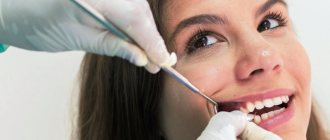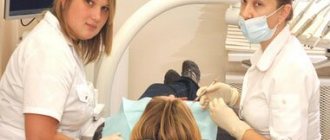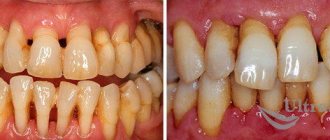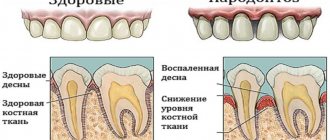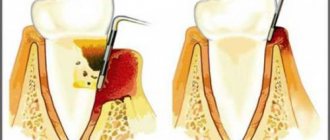From this article you will learn:
- What is the difference between periodontal disease and periodontitis?
- causes and symptoms of its development,
- how to treat periodontal disease at the dentist, as well as home therapy products.
The article was written by a dentist with more than 19 years of experience.
Periodontal disease is a disease of the gums, which is based on the process of sclerosis of blood vessels, which leads to a decrease in the supply of oxygen and nutrients, and as a result, there is a slow degeneration of all periodontal tissues (i.e., the bone tissue around the tooth, periodontal fibers attaching the tooth to bones, as well as soft tissues of the gums).
Typically, patients incorrectly use the term “periodontal disease” to refer to any existing gum disease. In fact, periodontal disease is a fairly rare disease, and most patients who complain about problems in the gums do not have periodontal disease, but actual chronic generalized periodontitis.
Periodontal disease: photos of teeth and gums
You can very easily check whether you have periodontitis or periodontal disease - the symptoms of the latter are a gradual decrease in the height of the gums and exposure of the roots of the teeth, which occurs due to the gradual process of sclerosis and dystrophy - usually in the absence of any inflammation in the gums. In turn, the presence of bleeding and soreness of the gums when brushing, swelling and redness of the gums indicates the presence of inflammation in the gums, i.e. about Periodontitis.
Diagnosis of periodontal disease
To identify signs of periodontal disease in adults, the following diagnostic procedures are usually performed:
- inspection;
- probing of the gingival sulcus;
- assessment of tooth mobility;
- X-ray examination (orthopantomography);
- biomicroscopy of the gums to determine the degree of microcirculation impairment.
The patient will also need observation from a general practitioner and endocrinologist to detect and treat general somatic pathology.
After a diagnosis of “dental disease periodontal disease” is made, further examination should be aimed at finding the causes of disturbances in the processes of cellular tissue nutrition, predicting the further development of the disease and the likelihood of inflammatory complications.
Symptoms of dental periodontal disease
The main symptom of the disease is detected during x-ray diagnosis of periodontal disease. The image shows a uniform decrease in the height of the interdental septa with alternating foci of osteosclerosis and osteoporosis in the deep parts of the alveolar process and the body of the jaw, as well as in other bones of the skeleton. Traditionally, changes are accompanied by the presence of diseases of the cardiovascular or endocrine systems and metabolic disorders.
There are other symptoms of severe periodontal disease that are more noticeable to the patient and others:
- gum retraction;
- exposure of the necks and roots of the teeth;
- pale gum color;
- lesions of teeth of non-carious origin (wedge-shaped defects, hyperesthesia).
Recipes for strengthening bone tissue:
- Take 20 g of myrrh, add 15 g of chopped mint and raspberry leaves. Dilute a mixture of 80 g of wine alcohol and 25 g of vinegar. Stir and pour into a glass jar. Leave for 3 days in a dark place. Afterwards, rinse your mouth twice a day.
- Pour 50 g of chopped sage into 100 g of boiling water. Leave covered for an hour. Rinse your mouth thoroughly.
- Chop fresh plantain leaves and crush well. Soak a clean cotton swab with the resulting juice and wipe the gums with it.
- Pour 30 g of dried calamus into 0.5 liters of vodka. Leave for a week in a dark place, then strain. Add 3 tbsp. l. mixture into a glass of water and rinse your mouth for 3-6 minutes.
- 6 tbsp. l. Mix crushed pine needles with a liter of boiling water. Bring to a boil, strain and set aside. Rinse your mouth morning and evening.
Stages of periodontal disease
In modern dentistry, there are three degrees of severity of periodontal disease.
Mild degree
How does periodontal disease begin? In the early stages, the disease occurs without pronounced symptoms with gradual atrophy of the gum edge and bone tissue. With periodontal disease of the anterior teeth, a slight exposure of the dental necks occurs; in some cases, patients experience increased sensitivity of teeth to food irritants (hot and cold, sweet and sour). On X-ray images, the onset of periodontal disease is indicated by the first signs of bone tissue atrophy.
Average degree
With an exacerbation of periodontal disease, not only the necks, but also the roots of the teeth are exposed - by 2 - 3 millimeters. X-ray images show destruction of bone tissue along half the length of the root and the presence of foci of sclerosis.
Severe degree
With severe periodontal disease, exposure of the roots of the teeth reaches 4–5 millimeters, bone tissue atrophy on X-ray photographs covers two-thirds of the root.
Always treat gum problems
When a patient comes to the doctor, he complains about something. What symptoms does he see a doctor with before receiving a diagnosis of periodontal disease? What worries him?
Literally, patients tell the doctor this: my gums have sagged, my gums have become exposed, my lower gums have receded. And for some reason the symptom of gum subsidence automatically means that the patient has the so-called. periodontal disease.
More experienced patients, who have already heard a lot of professional terms, who delve into the professional colloquial language of doctors, say this: “The necks of the teeth have become exposed a little, the teeth have become a little higher.” But, according to statistics, most patients complain about sagging gums.
And so, when patients come to the doctor with complaints about the problem of exposed tooth necks, the doctor diagnoses them with periodontal disease. Of course, he begins to treat them. And to treat it specifically for periodontal disease.
But time passes, money also goes away, and the question of why the gums recede and the necks of the teeth become exposed, why the gums recede, has not been resolved. And the patient still has periodontal disease.
Periodontal disease – what to do?
At the initial stage of periodontal disease, you should consult a periodontist. No folk remedies will help get rid of the disease. Only a specialist will be able to carry out the necessary diagnostic procedures and prescribe, based on the identified symptoms of periodontal disease, treatment aimed at slowing down degeneration in periodontal tissues and preventing inflammatory complications. It is also necessary to eliminate non-carious dental lesions and undergo a thorough examination by a therapist to diagnose and treat common diseases that provoke the development of periodontal disease.
Complex therapy of periodontal disease involves the following measures:
- Timely removal of dental plaque.
- Normalization of occlusal relationships (grinding teeth, prosthetics, splinting).
- The use of vitamins and agents that improve microcirculation (nicotinic acid, aloe extract, heparin).
Introduction
The information world is very huge. Each of us is haunted by a million points of view
for any problem in any field of knowledge, you just need to ask a search query. The same thing happens in medical circles on the Internet - discussions of health problems are widely represented by both patients and doctors and often reach the point of absurdity:
For example, in questions:
- loosening of the tooth,
- exposure of the neck of the tooth,
- why are my gums and teeth exposed?
that is, in situations where the gums on a tooth have receded, patients are always confused: they have periodontal disease
, then suddenly it changed to
periodontitis
, then periodontal disease returned again. And the search for an answer to the question becomes endless.
The problem of “how to treat periodontal disease” is picked up by doctors who only add fuel to the fire by recommending medications and even folk remedies for periodontal disease, without having sufficient competence to do so.
Let's consider these points of view professionally, and try to convey one simple truth, which for the vast majority of patients (and even some doctors) will be a revelation: the diagnosis of periodontal disease of the gums
» —
does not exist
.
An expert point of view is expressed by the famous periodontist, Doctor of Medical Sciences Laura Mikhailovna Tebloeva:
As a rule, for patients who come to me and say: “I have periodontal disease,” I always clarify - did you make this diagnosis yourself or did you see a doctor? Often patients answer that they have this information from their doctor. It turns out that the patient did not read somewhere and determine the diagnosis of “periodontal disease” for himself, but, unfortunately, such a diagnosis was made by a doctor.
Treatment methods
Methods and procedures used to treat periodontal disease in dentistry:
- exposure to high pressure oxygen in hyperbaric chambers;
- electrophoresis;
- diadynamic currents;
- amplipulse therapy;
- darsonvalization of gums;
- UHF therapy;
- gum massage;
- local hypo- and hyperthermia;
- ultrasound therapy.
Psychosomatics of periodontal disease
Based on the results of many years of research, American scientists have come to the conclusion that dental diseases such as periodontal disease are directly related to high anxiety, depression and an acute sense of loneliness. This is explained by the fact that increased levels of the stress hormone - cortisol - in the blood negatively affect the condition of the gums and jaw bones. In addition, during periods of nervous tension, people begin to pay less attention to oral hygiene and increase the doses of alcoholic beverages, nicotine and medications, which also contributes to the development of various diseases.
Regenerating drugs
The main problem in the treatment of periodontal disease is the restoration of tissues damaged or destroyed during the development of the disease. For this purpose, a variety of drugs are used, including stem cells and other biogenic stimulators of regenerative processes. They are most often administered by injection directly into the affected areas of the gums. Modern methods of treating periodontal disease include the use of the following drugs:
- Fibroblasts
Fibroblasts are connective tissue cells that play an extremely important role in the healing process of wounds and injuries, and also participate in the synthesis of collagen and elastin fibers, which make the soft tissues of the body more elastic. The introduction of fibroblasts helps restore the elasticity and firmness of sagging gum tissue, and also increases the protective properties of the mucous membranes of the oral cavity. The strength of fabrics and their resistance to destructive influences of various natures also increases significantly.
- Stem cells
The anti-aging properties of stem cells are widely known in modern medicine and, especially, cosmetology. Stem cell preparations can stimulate regenerative processes and promote accelerated restoration of cellular structures. Under their influence, the healing process of damage is accelerated, which is extremely important in the treatment of periodontal disease and related diseases.
- Platelet-derived growth factor
Platelet growth factor is a special protein synthesized by the body and involved in the processes of tissue growth and repair. In addition, the growth factor promotes accelerated synthesis of collagen, glycosaminoglycans and other components of connective tissue.
The use of biogenic drugs is an extremely promising direction in modern medicine, but these methods are not widely used today due to technological complexity and high cost. To stimulate recovery processes, you can use more accessible means, in particular propolis. This substance is included in a wide variety of hygiene, therapeutic and prophylactic products; in particular, it is the main active component of the antimicrobial gel for gums ASEPTA. In addition to stimulating tissue restoration, propolis also has a pronounced antimicrobial and anti-inflammatory effect, reduces the sensitivity of damaged gums, and eliminates bleeding.
Consequences of periodontal disease - why is it dangerous?
- Firstly, due to the absence of pronounced symptoms, this disease can progress unnoticed over many years and lead to total destruction of the teeth and jawbone - and then teeth fall out with periodontal disease.
- Secondly, the destruction of bone tissue leads to disturbances in the functioning of the gastrointestinal tract with the subsequent occurrence of diseases of the digestive system.
- Thirdly, advanced periodontal disease can provoke periodontitis - acute inflammation of the tissue and tooth loss.
In addition to the above consequences, generalized periodontal disease in an advanced stage causes another dangerous disease - osteomyelitis, that is, purulent bone damage.
What changes should you make to your diet?
It is important to strengthen bone tissue to eliminate periodontal disease. This is one of the goals of treatment. One of the main recommendations from experts concerns changing the menu. It is recommended to remove the following types of foods from your diet:
- chocolate;
- carbonated drinks;
- cookie;
- candies;
- waffles;
- gingerbread
The listed foods are rich in carbohydrates, which create an environment ideal for the proliferation of pathogens. It is recommended to enrich the menu with the following types of food:
- oily fish;
- boiled meat;
- cottage cheese, sour milk;
- fresh vegetables, fruits, berries;
- greens.
The foods listed above contain large amounts of proteins necessary for bone tissue restoration. You should also think about changing your toothbrush. Experts advise choosing products with soft bristles that are comfortable and do not cause discomfort. Such models do not cause mechanical injuries during use. When looking for a suitable toothpaste, it is better to give preference to products based on herbal ingredients.
Make an appointment by phone
Feedback
Periodontal disease - contagious or not?
To the questions “Is periodontal disease contagious?” or “Is periodontal disease transmitted by airborne droplets?” Doctors answer unequivocally in the negative. Therefore, you should not believe various dubious articles on the Internet about how periodontal disease is transmitted. The disease is associated with metabolic disorders, and not with the spread of bacteria. Therefore, those who believe that periodontal disease can be contracted or that the disease is transmitted through a kiss are deeply mistaken. However, despite this, we must not forget about the rules of daily oral hygiene in order to prevent the occurrence of other problems with teeth and gums.
Clinical researches
The effectiveness of ASEPTA products has been repeatedly proven clinically. For example, clinical trials of ASEPTA gum gel have proven that using ASEPTA gum gel with propolis for a week can reduce gum inflammation by 31%.
Repeated clinical studies have also proven that the two-component mouth rinse ASEPTA ACTIVE more effectively combats the causes of inflammation and bleeding compared to single-component rinses - it reduces inflammation by 41% and reduces bleeding gums by 43%.
Sources:
- The use of drugs from the Asepta line in the complex treatment of inflammatory periodontal diseases (N.V. Berezina E.N. Silantyeva S.M. Krivonos, Kazan State Medical Academy. Kazan.) N.V. BEREZINA, E.N. SILANTIEVA, S.M. KRIVONOS Kazan State Medical Academy
- The use of adhesive balm "Asepta®" in the treatment of inflammatory periodontal diseases L.Yu. OREKHOVA*, Dr. med. Sciences, Professor, Head of Department V.V. CHPP**, Dr. med. Sciences, Professor, Head of Department S.B. ULITOVSKY*, Dr. med. Sciences, Professor A.A. LEONTIEV*, dentist A.A. DOMORAD**, O.M. YAKOVLEV** SPbSMU named after. acad. I.P. Pavlova, St. Petersburg - *Department of Therapeutic Dentistry, **Department of Microbiology
- Study of the clinical effectiveness of treatment and prophylactic agents of the Asepta line in the treatment of inflammatory periodontal diseases (A.I. Grudyanov, I.Yu. Aleksandrovskaya, V.Yu. Korzunina) A.I. GRUDYANOV, Doctor of Medical Sciences, Prof., Head of Department I.Yu. ALEXANDROVSKAYA, Ph.D. V.Yu. KORZUNINA, asp. Department of Periodontology, Central Research Institute of Dentistry and Maxillofacial Surgery, Rosmedtekhnologii, Moscow
- The effectiveness of the use of Asept “adhesive balm” and Asept “gel with propolis” in the treatment of chronic generalized periodontitis and gingivitis in the acute stage (Municipal Dental Clinic No. 4, Bryansk, Kaminskaya T. M. Head of the therapeutic department Kaminskaya Tatyana Mikhailovna MUZ City Dental Clinic No. 4, Bryansk
